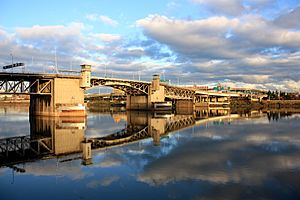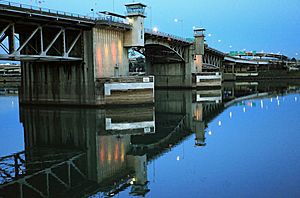Morrison Bridge facts for kids
Quick facts for kids Morrison Bridge |
|
|---|---|
 |
|
| Carries | motor vehicles, pedestrians, cyclists |
| Crosses | Willamette River |
| Locale | Portland, Oregon, U.S. |
| Maintained by | Multnomah County |
| ID number | 02758 |
| Characteristics | |
| Design | double-leaf "Chicago style" bascule |
| Total length | 760 feet (236.1 m) |
| Width | 90 feet (27.4 m) |
| Longest span | 284 feet |
| Clearance below | 69 feet closed |
| History | |
| Opened | May 24, 1958 (replaced 1887 and 1905 bridges) |
|
Morrison Bridge
|
|
| Location | Portland, Oregon; Willamette River at river mile 12.8 |
| MPS | Willamette River Highway Bridges of Portland, Oregon |
| NRHP reference No. | 12000933 |
| Added to NRHP | November 14, 2012 |

The Morrison Bridge is a special kind of bridge called a bascule bridge. It crosses the Willamette River in Portland, Oregon. This bridge was finished in 1958. It's actually the third bridge to stand in about the same spot with the same name! Many people use the Morrison Bridge every day. In November 2012, it was added to the National Register of Historic Places, which means it's an important historical landmark.
Contents
A Look Back: Earlier Morrison Bridges
The very first Morrison Bridge was built from wood. It was a swing bridge, meaning a part of it could swing open to let boats pass. This bridge opened on April 12, 1887. It was a big deal because it was the first bridge to cross the Willamette River in Portland. It was also the longest bridge west of the Mississippi River at that time!
The bridge got its name from Morrison Street. This street was named after John L. Morrison, who was an immigrant from Scotland. He built the first house on Morrison Street.
At first, people had to pay a fee to cross the bridge. This is called a toll bridge. For example, it cost 15 cents for a horse-drawn cart. But by 1895, it became free to cross.
A second Morrison Bridge, also a swing bridge, was built in 1905. However, it wasn't made for cars, which were becoming popular. So, a new bridge was needed, and the current one replaced it in 1958.
How People Crossed the Old Bridges
The first Morrison Bridge carried horsecars starting in 1888. Horsecars were like small trains pulled by horses. Later, electric streetcars took over in 1890. Streetcars also used the second Morrison Bridge. But by the time the third bridge opened in 1958, Portland's streetcar system had stopped running. So, the newest Morrison Bridge never carried streetcars.
The Modern Morrison Bridge: Its Story
The current Morrison Bridge was built by Multnomah County. It cost $12.9 million and opened on May 24, 1958. A few years later, in 1961, ramps were added to connect the bridge to major highways like Interstate 5 and Interstate 84.
Lighting Up the Bridge
In 1987, the Morrison Bridge became the first bridge to be lit up by the Willamette Light Brigade. This group helps light up bridges in Portland. In 2007, the old lights were replaced with new, energy-saving LED lights. These new lights can change colors and patterns! You can even request special colors for a fee.
Making It Better for Everyone
In 2009, a project started to make the bridge safer for people walking and biking. They added a special path on the south side, separated from car traffic. Before this, the sidewalks were very narrow.
From 2011 to 2012, the bridge got another big upgrade. The old steel grates on the moving part of the bridge were replaced. They put in new panels made of a strong, light material called fiber-reinforced polymer. This helps cars get better grip. The work finished in March 2012. The bridge was also added to the National Register of Historic Places in November 2012.
How the Bridge Works and What It's Like

The Morrison Bridge is a huge machine! It's actually the largest mechanical device in Oregon. Inside each of the bridge's piers (the big supports), there are giant gears. These gears help lift huge 940-ton weights. These weights help the bridge open and close.
When the bridge is closed, there's 69 feet of space underneath for boats to pass. This is enough for most river traffic. The bridge only needs to open about 30 times a month to let taller boats go by.
Today, about 50,000 vehicles cross the bridge every day using its six lanes. The control tower, where the bridge operator works, has slanted windows. This makes it look a bit like an air traffic control tower at an airport.
The current bridge doesn't line up perfectly with Morrison Street on its west side. This is because the second bridge was still in use while the new one was being built. So, they had to build the new bridge in a slightly different spot.
In 2005, the bridge opened for river traffic about 33 times each month.



